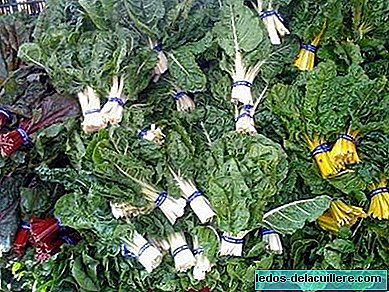
In our Special dedicated to Infant Feeding we saw that there were certain vegetables not recommended for babies before 12 months, and the main reason was the presence of high amounts of nitrates, which could be harmful to the organism of the little ones.
We stop next in some tips to reduce or mitigate the nitrate content of vegetables, something that will make the family menu healthier.
If we choose green leafy vegetables (spinach, chard, lettuce, cabbage) we can remove the outermost and greenest leaves of these vegetables rich in nitrates, since it is the greenest leaves that concentrate a greater amount of nitrates (but also vitamins ).
We must carefully wash, and better one by one, the leaves of the vegetable to be consumed raw. This eliminates parts of nitrates and nitrites, very water soluble compounds.
If we know the origin, it is preferable to opt for vegetables grown outdoors compared to those of greenhouse, because they are grown in an environment of lower amount of light and higher temperature that causes vegetables to accumulate greater amounts of nitrates.
You have to wash the vegetables and fruits, then rub them lightly with a cloth.
For baby porridge you have to choose vegetables that accumulate less nitrates at the beginning, such as leek, squash and zucchini, peas, green beans, potatoes, sweet potatoes ...
In winter, seasonal vegetables should be preferred. The different types of cabbage, escarole and turnips will then be consumed ... whenever possible grown outdoors.
One of the safest means of alleviating the intake of vegetables contaminated by nitrates in all seasons is to consume products from organic farming, which should not use chemical fertilizers or soluble organic fertilizers such as pig purines, which have the same effect. In winter the concentration of nitrates in organic crops is much lower than in conventional crops.
It is not necessary to reheat previously cooked vegetables, as this increases the proportion of nitrites.
In order to largely neutralize the intake of nitrates in winter vegetables and vegetables, it is effective to follow a diet rich in vitamin C, which is obtained by consuming large amounts of fruits, especially acidic fruits. It has been shown through numerous studies that vitamin C significantly reduces the amount of nitrites in the body, and that it reacts more rapidly with nitrites than amines, so that the production of nitrosamines is highly halted within human metabolism.
Avoid vegetables packaged in plastics, since nitrites develop mostly during storage in humid, non-aerated places. At room temperature, the bacteria that transform nitrates into nitrites multiply rapidly.
Cooking reduces the presence of nitrates (but also favorable nutrients.)
It is recommended not to take advantage of the cooking water of those vegetables rich in nitrates for the preparation of soups or purees.
Always acquire fresh and ripe vegetables, avoiding the first products that have been grown in greenhouses, as well as those harvested out of their time, since they are the most treated products. Do not keep them for a long time, consume them as soon as possible, either raw or cooked.
We hope all these tips to reduce the nitrate content of vegetables Help make the family diet a little healthier. And remember that choosing vegetables well, and especially consuming them in an extensive and varied way, giving special importance to vegetables that accumulate less nitrates, all are benefits for the body.












